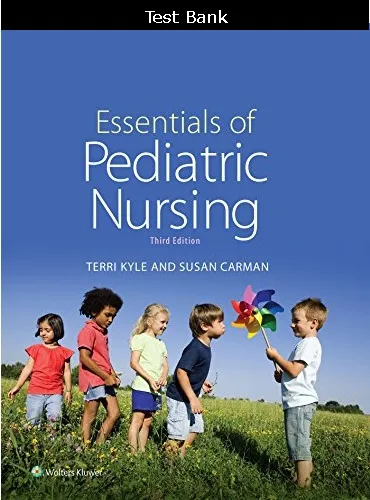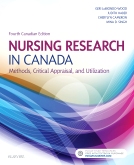Essentials of Pediatric Nursing 3rd edition Kyle, Carman Test Bank
$55.00 Original price was: $55.00.$19.50Current price is: $19.50.
Digital item No Waiting Time Instant Download
Chapters: 29
Format: PDF
ISBN-13: 978-1451192384
ISBN-10: 145119238X
Publisher: LWW
Authors: Theresa Kyle, Susan Carman
Description
Essentials of Pediatric Nursing 3rd edition Kyle, Carman Test Bank
Table of Contents
Origin: Chapter 1, 1
1. The nurse providing family-centered care in a hospital setting reflects on the focus of
the health care provided in today’s society. Which statement best describes the current
definition of health?
A) Health is described as ‘an absence of disease.’
B) Health is measured by monitoring mortality and morbidity of a group.
C) Health is a state of complete physical, mental, and social well-being.
D) Technological gains made in health care are shared equally among all children.
Ans: C
Feedback:
In the past, health was defined simply as the absence of disease; health was measured by
monitoring the mortality and morbidity of a group. Over the past century, however, the
focus of health has shifted to disease prevention, health promotion, and wellness. The
World Health Organization (2013) defines health as “a state of complete physical,
mental, and social well-being, and not merely the absence of disease or infirmity.” The
gains in child health have been huge, but, unfortunately, these gains are not shared
equally among all children.
Origin: Chapter 1, 2
2. The student nurse is learning about the past history of child health and health care in the
United States. Which statement accurately reflects the condition of health care in the
past and current centuries?
A) In past centuries in the United States, the health of the country was better than it is
today due to the simpler style of living.
B) In the current century, mortality rates are high, but life expectancy has increased
due to technological advances.
C) In the late eighteenth and early nineteenth centuries urban public health
improvements made cities healthier places for growing children.
D) By the late twentieth century unintentional injuries rather than infectious diseases
had become the leading cause of death for children older than 1 year old.
Ans: D
Feedback:
In past centuries in the United States, the health of the country was poorer than it is
today; mortality rates were high and life expectancy was short. Over the years the health
of children received more and more attention, leading to a better understanding of
sources of illness and improvements in sanitation, water, and nutrition. As a result, by
the late twentieth century unintentional injuries rather than infectious diseases had
become the leading cause of death for children older than 1 year old.
Page 2
Origin: Chapter 1, 3
3. The nurse is administering a number of therapeutic interventions for neonates, infants,
and children on the pediatric unit. Which intervention contributes to an increase in
chronic illness seen in early childhood?
A) Administering antibiotics to prevent lethal infections
B) Vaccinating children to prevent childhood diseases
C) Using mechanical ventilation for premature infants
D) Using corticosteroids as a treatment for asthma
Ans: C
Feedback:
Using mechanical ventilation and medications to foster lung development in premature
infants increases their survival rate. Yet the infants who survive are often faced with
myriad chronic illnesses. Administering antibiotics to prevent lethal infections,
vaccinating children to prevent childhood diseases, and using corticosteroids as a
treatment for asthma may cause side effects, but do not contribute to chronic illness in
children.
Origin: Chapter 1, 4
4. The nurse is reviewing a copy of the U.S. Surgeon General’s Report, Healthy People.
Which nursing action best reflects the nurse fostering this health care agenda?
A) The nurse signs up for classes to obtain an advanced degree in nursing
B) The nurse volunteers at a local health care clinic providing free vaccinations for
low-income populations
C) The nurse performs an in-service on basic hospital equipment for student nurses
D) The nurse compiles nursing articles on evidence-based practices in nursing to
present at a hospital training seminar
Ans: B
Feedback:
Healthy People is a comprehensive health promotion and disease prevention agenda that
is working toward improving the quantity and quality of life for all Americans (U.S.
Department of Health and Human Services, 2010). Overarching goals are to eliminate
preventable disease, disability, injury, and premature death; achieve health equity,
eliminate disparities, and improve the health of all groups; create physical and social
environments that promote good health; and promote healthy development and
behaviors across every stage of life. Volunteering at a local health care clinic directly
reflects the goal of improving the health of all groups of people. Signing up for classes,
performing in-services on equipment, and compiling nursing articles on evidence-based
practices in nursing are all worthwhile activities that foster health care delivery, but are
not as directly linked to the agenda of promoting health in the community.
Page 3
Origin: Chapter 1, 5
5. The neonatal nurse researches the neonatal and mortality rates in the United States.
Which statements accurately describe these measurements of child health? Select all
that apply.
A) Neonatal mortality is the number of infant deaths occurring in the first 28 days of
life per 1,000 live births.
B) The infant mortality rate refers to the number of deaths occurring in the first 6
months of life.
C) Neonatal mortality is documented as the number of deaths in relation to 1,000 live
births.
D) The infant mortality rate is used as an index of the general health of a country.
E) In 2007, the infant mortality rate in the United States was 6.8 per 1,000 live births.
F) The infant mortality rate is consistent from state to state as well as between ethnic
groups.
Ans: A, C, D, E
Feedback:
Neonatal mortality is the number of infant deaths occurring in the first 28 days of life
per 1,000 live births. The infant mortality rate refers to the number of deaths occurring
in the first 12 months of life and is documented as the number of deaths in relation to
1,000 live births. The infant mortality rate is used as an index of the general health of a
country; generally, this statistic is one of the most significant measures of children’s
health. In 2007, the infant mortality rate in the United States was 6.8 per 1,000 live
births. The infant mortality rate varies greatly from state to state as well as between
ethnic groups.





Be the first to review “Essentials of Pediatric Nursing 3rd edition Kyle, Carman Test Bank”